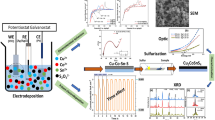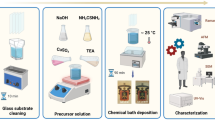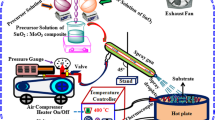Abstract
This study reports direct electrodeposition of TiOx thin films on ITO substrate from an acetonitrile solution containing titanyl sulfate and tetra n-butyl ammonium hydroxide. The electrochemical behavior of titanyl sulfate in a basic medium is investigated using cyclic voltammetry. In this medium, different phases and/or compositions containing Ti3O5 (βTi3O5, λTi3O5, and ɣTi3O5) and Ti4O7 are obtained depending on electrolysis potential values (− 1.2 V, − 1.5 V, − 1.7 V, and − 2.0 V). The electrochemical properties of the TiOx coatings obtained from various cathodic potentials are investigated using electrochemical impedance spectroscopy (EIS). Depending on the increase of electrolysis potential values applied, thicker films with lower resistance are formed. The EIS analysis results are compatible with the results of XRD and SEM, which confirms the change of phase content and/or composition in the films obtained at different electrolysis potential values. The estimated band gaps of brownish thin films are obtained between 1.32 and 1.41 eV using UV–vis spectra. Herein the electrochemical deposition of crystalline TiOx films on ITO electrode is carried out at room temperature by a cost-effective and one-step method in basic acetonitrile solution.









Similar content being viewed by others
References
Fujishima A, Hashimioto K, Watanabe T (1999) TiO2 photocatalysis fundamentals and applications. BKC Inc, Tokyo
Satterfield CN (1991) Heterogeneous catalysis in industrial practice. McGraw-Hill, New York
Mi Y, Wen L, Xu R, Wang Z, Cao D, Fang Y, Lei Y (2016) Constructing a AZO/TiO2 core/shell nanocone array with uniformly dispersed Au NPs for enhancing photoelectrochemical water splitting. Adv Energy Mater 6:1501496
Ma Y, Wang X, Jia Y, Chen X, Han H, Li C (2014) Titanium dioxide-based nanomaterials for photocatalytic fuel generations. Chem Rev 114(19):9987–10043
Selhofer H, Ritter E, Linsbod R (2002) Properties of titanium dioxide films prepared by reactive electron-beam evaporation from various starting materials. Appl Opt 41(4):756–762
Roose B, Pathak S, Steiner U (2015) Doping of TiO2 for sensitized solar cells. Chem Soc Rev 44(22):8326–8349
O'regan B, Grätzel M (1991) A low-cost high-efficiency solar cell based on dye-sensitized colloidal TiO2 films. Nature 353:737–740
Wang B, Shen S, Mao SS (2017) Black TiO2 for solar hydrogen conversion. J Mater 3:96–111
Bowker M, Bennett R (2009) The role of Ti3+ interstitials in TiO2 (110) reduction and oxidation. J Phys Condens Matter 21:474224
Yusoff ARM, Kim HP, Jang J (2013) Inverted organic solar cells with TiOx cathode and graphene oxide anode buffer layers. Sol Energy Mater Sol Cells 109:63–69
Walsh F, Wills R (2010) The continuing development of Magnéli phase titanium sub-oxides and Ebonex® electrodes. Electrochim Acta 55:6342–6351
Xu B, Sohn HY, Mohassab Y, Lan Y (2016) Structures, preparation and applications of titanium suboxides. RSC Adv 679:706–79722
Ohkoshi S, Tsunobuchi Y, Matsuda T, Hashimoto K, Namai A, Hakoe F, Tokoro H (2010) Synthesis of a metal oxide with a room-temperature photoreversible phase transition. Nat Chem 2(7):539–545
Regonini D, Dent AC, Bowen CR, Pennock SR, Taylor J (2011) Impedance spectroscopy analysis of TinO2n−1 Magnéli phases. Mater Lett 65:3590–3592
Dubrovinsky LS, Dubrovinskaia NA, Swamy V, Muscat J, Harrison NM, Ahuja R, Holm B, Johansson B (2001) Materials science: the hardest known oxide. Nature 410(6829):653–654
Liu L, Chen X (2014) Titanium dioxide Nanomaterials: self-structural modifications. Chem Rev 114(19):9890–9918
Cronemeyer D, Gilleo M (1951) The optical absorption and photoconductivity of rutile. Phys Rev 82:975–976
Chen X, Liu L, Peter YY, Mao S (2011) Increasing solar absorption for photocatalysis with black hydrogenated titanium dioxide nanocrystals. Science 331(6018):746–750
Ullattil SG, Narendranath SB, Pillai SC, Periyat P (2018) Black TiO2 nanomaterials:a review of recent advances. Chem Eng J 343:708–736
Fang W, Xing M, Zhang J (2017) Modifications on reduced titanium dioxide photocatalysts: a review. J Photoch Photobio C: Photochemistry Reviews 32:21–39
Teng F, Li M, Gao C, Zhang G, Zhang P, Wang Y, Chen L, Xie E (2014) Preparation of black TiO2 by hydrogen plasma assisted chemical vapor deposition and its photocatalytic activity. Appl Catal B Environ 148:339–343
Zhao H, Pan F, Li Y (2017) A review on the effects of TiO2 surface point defects on CO2 photoreduction with H2O. J Mater 3:17–32
Dong W, Li H, Xi J, Mu J, Huang Y, Ji Z, Wu X (2017) Reduced TiO2 nanoflower structured photoanodes for superior photoelectrochemical water splitting. J Alloys Compd 724:280–286
Tian J, Hu X, Yang H, Zhou Y, Cui H, Liu H (2016) High yield production of reduced TiO2 with enhanced photocatalytic activity. Appl Surf Sci 360:738–743
Zhang Z, Hedhili MN, Zhu H, Wang P (2013) Electrochemical reduction induced self-doping of Ti3+ for efficient water splitting performance on TiO2 based photoelectrodes. Phys Chem Chem Phys 15(37):15637–15644
Mo LB, Wang Y, Bai Y, Xiang QY, Li Q, Yao WQ, Wang JO, Ibrahim K, Wang HH, Wan CH (2015) Hydrogen impurity defects in rutile TiO2. Sci Rep 5:17634
Chen WP, He KF, Wang Y, Chan HLW, Yan Z (2013) Highly mobile and reactive state of hydrogen in metal oxide semiconductors at room temperature. Sci Rep 3:3149
Zhu WD, Wang CW, Chen JB, Li Y, Wang J (2014) Enhanced field emission from Ti3+ self-doped TiO2 nanotube arrays synthesized by a facile cathodic reduction process. Appl Surf Sci 301:525–529
Teleki A, Pratsinis SE (2009) Blue nano titania made in diffusion flames. Phys Chem Chem Phys 11(19):3742–3747
Komaguchi K, Maruoka T, Nakano H, Imae I, Ooyama Y, Harima Y (2010) Electron-transfer reaction of oxygen species on TiO2 nanoparticles induced by sub-band-gap illumination. J Phys Chem C 114:1240–1245
Zuo F, Wang L, Wu T, Zhang Z, Borchardt D, Feng P (2010) Self-doped Ti3+ enhanced photocatalyst for hydrogen production under visible light. J Am Chem Soc 132(34):11856–11857
Kitada A, Hasegawa G, Kobayashi Y, Kanamori K, Nakanishi K, Kageyama H (2012) Selective preparation of macroporous monoliths of conductive titanium oxides TinO2n–1 (n= 2, 3, 4, 6). J Am Chem Soc 134(26):10894–10898
Arif AF, Balgis R, Ogi T, Iskandar F, Kinoshita A, Nakamura K, Okuyama K (2017) Highly conductive nano-sized Magnéli phases titanium oxide (TiOx). Sci Rep 7:3646
Gusev A, Avvakumov E, Medvedev AZ, Masliy A (2007) Ceramic electrodes based on Magneli phases of titanium oxides. Sci Sinter 39:51–57
Acha C, Monteverde M, Nunez-Regueiro M, Kuhn A, Franco MA (2003) Electrical resistivity of the Ti4O7 Magneli phase under high pressure. Eur Phys J B-Condensed Matter and Complex Systems 34:421–428
Andersson S, Collén B, Kuylenstierna U, Magnéli A (1957) Phase analysis studies on the titanium-oxygen system. Acta Chem Scand 11:1641–1652
Huang B, Huang W, Shi Q, Zheng S, Shen Z (2017) The preparation and phase transformation characteristics of γ-Ti3O5 thin film. J Mater Sci Mater Electron 28:7868–7873
Li H, Zhou T, Hu S, Su Z, Yan Y (2017) Ti6O11 nanofiber: a new material with robust switching characteristic for memories. Chem Eng J 312:328–335
Krishnan P, Advani SG, Prasad AK (2012) Magneli phase TinO2n − 1 as corrosion-resistant PEM fuel cell catalyst support. J Solid State Electrochem 16:2515–2521
Ellis K, Hill A, Hill J, Loyns A, Partington T (2004) The performance of Ebonex® electrodes in bipolar lead-acid batteries. J Power Sources 136:366–371
Chen Y, Mao J (2014) Sol–gel preparation and characterization of black titanium oxides Ti2O3 and Ti3O5. J Mater Sci Mater Electron 25:1284–1288
Tu R, Huo G, Kimura T, Goto T (2010) Preparation of Magnéli phases of Ti27O52 and Ti6O11 films by laser chemical vapor deposition. Thin Solid Films 518:6927–6932
Kamada K, Mukai M, Matsumoto Y (2002) Electrodeposition of titanium (IV) oxide film from sacrificial titanium anode in I2-added acetone bath. Electrochim Acta 47:3309–3313
Acevedo-Peña P, González F, González G, González I (2014) The effect of anatase crystal orientation on the photoelectrochemical performance of anodic TiO2 nanotubes. Phys Chem Chem Phys 16(47):26213–26220
Jung MH, Chu MJ, Kang MG (2012) TiO2 nanotube fabrication with highly exposed (001) facets for enhanced conversion efficiency of solar cells. Chem Commun 48(41):5016–5018
Lee S, Park IJ, Kim DH, Seong WM, Kim DW, Han GS, Kim JY, Jung HS, Hong KS (2012) Crystallographically preferred oriented TiO2 nanotube arrays for efficient photovoltaic energy conversion. Energy Environ Sci 7:57989–57995
Yang Z, Ma Z, Pan D, Chen D, Xu F, Chen S (2014) Enhancing the performance of front-illuminated dye-sensitized solar cells with highly [001] oriented, single-crystal-like TiO2 nanotube arrays. Ceram Int 40:173–180
Ertekin Z, Tamer U, Pekmez K (2015) Cathodic electrochemical deposition of Magnéli phases TinO2n-1 thin films at different temperatures in acetonitrile solution. Electrochim Acta 163:77–81
Zheng L (2003) The oxygen sensing properties and mechanisms of M-doped α-Ti3O5 thin films (M= Ce, W ions). Sensor Actuat B: Chemical 94:294–297
Kar P, Evans JW (2006) Determination of kinetic parameters by modeling of voltammograms for electrochemical reduction of titanium dioxide. Electrochem Commun 8:1397–1403
Lasia A (2009) Handbook of fuel cells – fundamentals, technology and applications: the hydrogen oxidation/evolution reaction. John Wiley & Sons 2(4):416–440
Chen W, Wang Y, Dai J, Lu S, Wang X, Lee P, Chan HL, Choy C (2004) Spontaneous recovery of hydrogen-degraded TiO2 ceramic capacitors. Appl Phys Lett 84:103–105
Kunat M, Burghaus U, Wöll C (2004) The adsorption of hydrogen on the rutile TiO2 (110) surface. Phys Chem Chem Phys 6:4203–4207
Islam MM, Calatayud M, Pacchioni G (2011) Hydrogen adsorption and diffusion on the anatase TiO2 (101) surface: a first-principles investigation. J Phys Chem C 115:6809–6814
Idígoras JS, Berger T, Anta JA (2013) Modification of mesoporous TiO2 films by electrochemical doping: impact on photoelectrocatalytic and photovoltaic performance. J Phys Chem C 117:1561–1570
Berger T, Lana-Villarreal T, Monllor-Satoca D, Gómez R (2006) Charge transfer reductive doping of nanostructured TiO2 thin films as a way to improve their photoelectrocatalytic performance. Electrochem Commun 8:1713–1718
Minguzzi A, Sánchez-Sánchez CM, Gallo A, Montiel V, Rondinini S (2014) Evidence of facilitated electron transfer on hydrogenated self-doped TiO2 nanocrystals. Chem Electro Chem 1:1415–1421
Abaci S, Pekmez K, Hökelek T, Yildiz A (2000) Investigation of some parameters influencing electrocrystallisation of PbO2. J Power Sources 88:232–236
Hong S (1982) Crystal growth of some intermediate titanium oxide phases γ-Ti305, β-Ti305, Ti407 and Ti203 by chemical transport reactions. Acta Chemica Scandinavia A 36:207–217
Liu Y, Luo F, Su J, Zhou W, Zhu D, Zhou L (2015) Influence of oxidation on the dielectric and microwave absorption properties of the milled Ti3SiC2 powders. J Alloys Compd 644:404–410
Wu Y, Zhang Q, Wu X, Qin S, Liu J (2012) High pressure structural study of β-Ti3O5: X-ray diffraction and Raman spectroscopy. J Solid State Chem 192:356–359
Li X, Liu Y, Ma S, Ye J, Zhang X, Wang G, Qiu Y (2015) The synthesis and gas sensitivity of the β-Ti3O5 powder: experimental and DFT study. J Alloys Compd 649:939–948
Grey I, Li C, Madsen I (1994) Phase equilibria and structural studies on the solid solution MgTi2O5-Ti3O5. J Solid State Chem 113:62–73
Watanabe M (2009) Raman spectroscopy of charge-ordered states in Magnéli titanium oxides. Phys Status Solidi C 6:260–263
Lopez R, Gomez R (2012) Band-gap energy estimation from diffuse reflectance measurements on sol–gel and commercial TiO2: a comparative study. J Sol-Gel Sci Technol 61:1–7
Whan B, Shen S, Mao SS (2017) Black TiO2 for solar hydrogen conversion. J Mater 3:96–111
Santamaria M, Conigliaro G, Franco DF, Megna B, Quartoa DF (2017) Electronic properties of thermal oxides on Ti and their influence on impedance and photoelectrochemical behavior of TiO2 nanotubes. J Electrochem Soc 164(4):C113–C120
Chen X, Liu L, Huang F (2015) Black titanium dioxide (TiO2) nanomaterials. Chem Soc Rev 44(7):1861–1885
Dash CS, Sahoo S, Prabaharan S (2018) Resistive switching and impedance characteristics of M/TiO2− x/TiO2/M nano-ionic memristor. Solid State Ionics 324:218–225
Lačnjevac U, Jović B, Jović V, Radmilović V, Krstajić N (2013) Kinetics of the hydrogen evolution reaction on Ni-(Ebonex-supported Ru) composite coatings in alkaline solution. Int J Hydrog Energy 38:10178–10190
Cesiulis H, Tsyntsaru N, Ramanavicius A, Ragoisha G (2016) The study of thin films by electrochemical impedance spectroscopy, nanostructures and thin films for multifunctional applications. Springer, Switzerland
Chen SH, Ho SC, Chang CH, Chen CC, Say WC (2016) Influence of roughness on in-vivo properties of titanium implant surface and their electrochemical behavior. Surf Coat Technol 302:215–226
Ecker B, Egelhaaf HJ, Steim R, Parisi JR, von Hauff E (2012) Understanding S-shaped current–voltage characteristics in organic solar cells containing a TiOx interlayer with impedance spectroscopy and equivalent circuit analysis. J Phys Chem C 116:16333–16337
Alves A, Wenger F, Ponthiaux P, Celis JP, Pinto A, Rocha LA, Fernandes JCS (2017) Corrosion mechanisms in titanium oxide-based films produced by anodic treatment. Electrochim Acta 234:16–27
Funding
This study was financially supported by the Hacettepe University Scientific Research Unit (Project No.: 01401601002).
Author information
Authors and Affiliations
Corresponding author
Additional information
Publisher’s note
Springer Nature remains neutral with regard to jurisdictional claims in published maps and institutional affiliations.
Highlights
• TiOx films were prepared by a simple cathodic electrodeposition in basic acetonitrile.
• At room temperature, brownish and crystalline TiOx films were obtained.
• Depending on the applied potential, crystral structure of TiOx was changed.
Rights and permissions
About this article
Cite this article
Ertekin, Z., Pekmez, N.Ö. & Pekmez, K. One-step electrochemical deposition of thin film titanium suboxide in basic titanyl sulfate solution at room temperature. J Solid State Electrochem 24, 975–986 (2020). https://doi.org/10.1007/s10008-020-04555-9
Received:
Revised:
Accepted:
Published:
Issue Date:
DOI: https://doi.org/10.1007/s10008-020-04555-9




